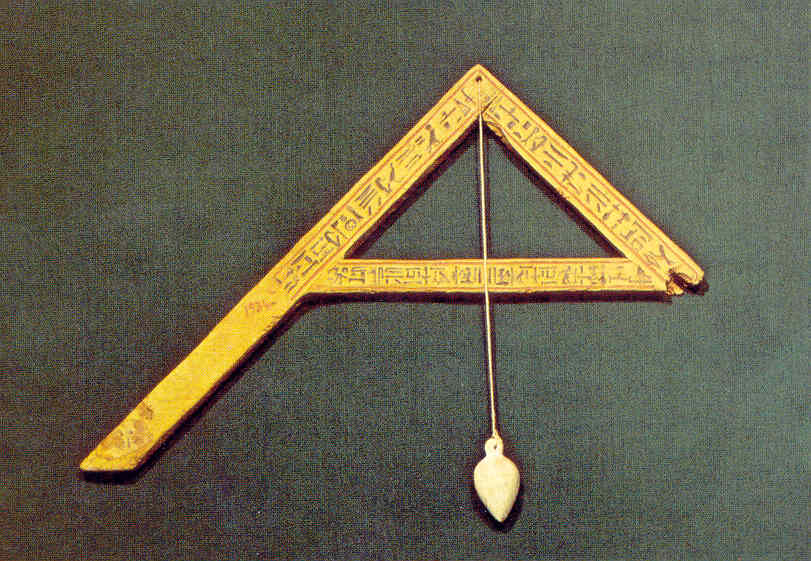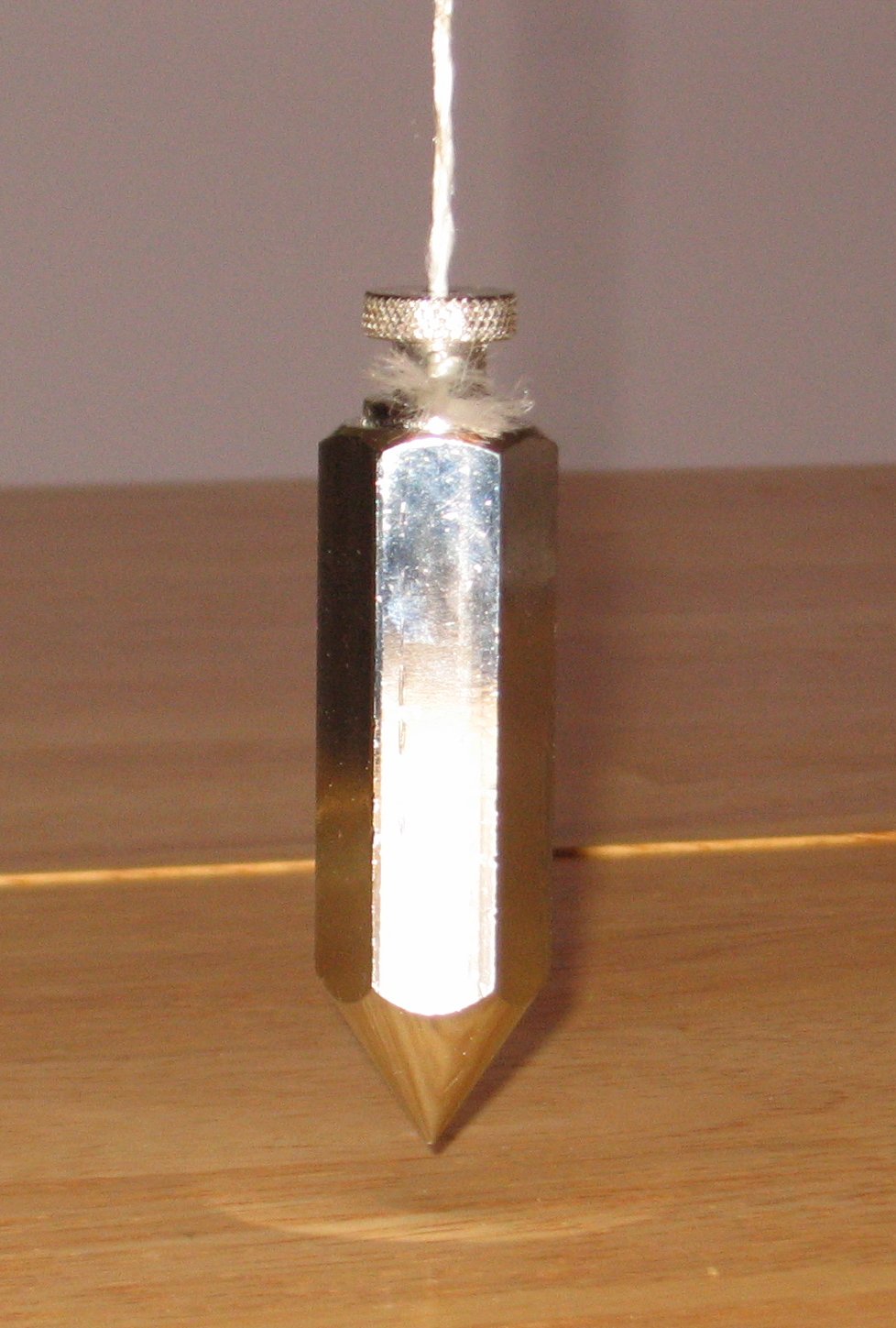A plumb bob, or plummet, is a weight, usually with a pointed tip on the bottom, suspended from a string and used as a vertical reference line, or plumb-line. It is a precursor to the spirit level and used to establish a vertical datum.
The instrument has been used since at least the time of ancient Egypt[1] to ensure that constructions are 'plumb', or vertical. It is also used in surveying, to establish the nadir with respect to gravity of a point in space. It is used with a variety of instruments (including levels, theodolites, and steel tapes) to set the instrument exactly over a fixed survey marker or to transcribe positions onto the ground for placing a marker.[2]
Etymology[edit]
The plumb in plumb bob derives from Latin plumbum ('lead'), the material once used for the weighted bob at the end.[3] The adjective plumb developed by extension, as did the noun aplomb, from the notion of 'standing upright.'
Use[edit]

Plumb Bobs 10 products Use a high quality plumb bob from Grainger to help make sure structural walls and doorjambs are vertical, to line up points when surveying and for many other jobs where establishing a true vertical is required. Shop here for brass and steel plumb bobs in.
- Unmarked plumb bob - 7.7 oz., 3 3/4 inches long - 739v. 83 00002, 8 oz plumb bob - 734c. Unmarked larger plumb bob- 739s. Hanson round plumb bobs (2)- 739r. Unmarked plumb bob, 2 5/8 inches- 4.3 oz - 739l. Great neck, made in tiawan, 12 oz- 4.
- TAJIMA Plumb Bob Setter - 14 oz (400g) Magnetic Plumb-Rite with 14.5 ft Auto Recoil Cord & Quick-Stabilizing Bob - PZB-400GP 4.8 out of 5 stars 708 $42.89 $ 42.

Until the modern age, plumb bobs were used on most tall structures to provide vertical datum lines for the building measurements. A section of the scaffolding would hold a plumb line, which was centered over a datum mark on the floor. As the building proceeded upward, the plumb line would also be taken higher, still centered on the datum. Many cathedral spires, domes and towers still have brass datum marks inlaid into their floors, which signify the center of the structure above.
A plumb bob and line alone can determine only a vertical reference. However, if they are mounted on a suitable scale the instrument may also be used as an inclinometer to measure angles to the vertical.
Ancient Egyptians used a plumb line attached to the top outer part of a tool resembling a letter E; when placed against a wall, the plumb line would indicate a vertical line. An A-frame level with a plumb line hung from the vertex was also used to find horizontal; these were used in Europe until the mid–19th century. A variation of this tool has the plumb line hung from the top of an inverted T shape.[3]
The early skyscrapers used heavy plumb bobs, hung on wire in their elevator shafts.[further explanation needed]
A plumb bob may be in a container of water (when conditions are above freezing temperatures), molasses, very viscous oils or other liquids to dampen any swinging movement,[4] functioning as a shock absorber.
Determining center of gravity of an irregular shape[edit]
Students of figure drawing will also make use of a plumb line to find the vertical axis through the center of gravity of their subject and lay it down on paper as a point of reference. The device used may be purpose-made plumb lines, or simply makeshift devices made from a piece of string and a weighted object, such as a metal washer. This plumb line is important for lining up anatomical geometries and visualizing the subject's center of balance.
See also[edit]
References[edit]
- ^Denys A. Stocks. Experiments in Egyptian archaeology: stoneworking technology in ncient Egypt. Routledge; 2003. ISBN978-0-415-30664-5. p. 180.
- ^Brinker, Russell Charles; Minnick, Roy, eds. (1995). The surveying handbook. Springer. pp. 93–94. ISBN978-0-412-98511-9.
- ^ abMcGeough, Joseph A.; Hartenberg, Richard S. (2019). 'Hand tool | Measuring and defining tools | Plumb line, level, and square'. Encyclopaedia Britannica.
- ^Staley, W. W.. Introduction to mine surveying,. 2nd ed. Stanford University, Calif.: Stanford University Press, 1964. Print. 138.

Plumb Bob Lowes
External links[edit]
| Wikimedia Commons has media related to Plumb bobs. |
- 60 oz. Plumb Bob.
- String Line and Plumb Bob.
Also called a plummet, a plumb bob is a very simple device. It consists of a small weight with a pointed bottom that is attached to the bottom of a piece of string. The string is usually made from either cotton or nylon, and the weight is typically made from brass or steel.
When the weight is allowed to dangle, it pulls the string into a vertical line that is referred to as a plumb line. The plumb bob gives architects and builders a vertical reference point during construction. It can be used for all kinds of construction projects, from building a bridge to hanging art on the walls.
The term “plumb bob” is sometimes used in golf to refer to a putting technique. The golfer squats behind the golf ball when it is on the green and extends the putter toward the hole. Then, the golfer compares the green on either side of the putter to see which way the ball will break. While the accuracy of this technique is debated among professionals, it is based on the same ideas that make the plumb bob device useful.
History of the Plumb Bob
Most historians agree that the first plumb bob was invented in Egyptian times. Used for architecture, sailing, and surveying the skies, the device likely played a major role in constructing the pyramids. The weight was usually made from a rock or some other kind of heavy object. It was installed inside a frame that allowed it to turn horizontally and vertically: acting as both a level and a plumb bob.
The word itself is said to have come from plumbum, a Latin word that means “lead”. This is likely because the metal, lead, was used for the earliest weights.
In the 1800s, the level was invented. It largely eliminated the need to use a plumb bob as a horizontal measurement device. The level was more compact, efficient, and usually gave a more accurate reading. However, the plumb bob was still very useful for buildings, bridges, and more.
The modern day plumb bob hasn’t changed much from the original version. The first weights were usually made from rocks or stones, then replaced by lead, then finally steel and brass. The weights are still pointed and come with a string to dangle the weight.
There is also a modern adaptation of the plumb bob: laser levels. These devices will project vertical and horizontal laser lines on the wall.
What Is a Plumb Bob Used for?
A plumb bob is a weight that is used to find the center of gravity in order to provide builders with a true vertical line: the plumb line.
Plumb bobs are frequently used in construction when you need to find a vertical line. For example, builders might use it to construct uniform stair steps or to check walls to make sure they are straight. Homeowners can use the plumb bob for a variety of DIY projects, such as hanging picture frames, installing a stud, or hanging a door.
Just like the design, the uses for the plumb bob have not changed much from the earliest version. The first plumb bobs were used to construct huge architectural structures for one of the most advanced civilizations of the time.
For years, plumb bobs were used to survey buildings such as cathedrals and churches. They are still used today in many historical buildings where modern tools would be disruptive — though in some cases, surveyors are turning to high-tech lasers to get their measurements.
Historically, these simple tools were used for both horizontal and vertical measurements, but today, the level is a much more accurate device for finding a true horizontal angle.
How to Use a Plumb Bob
Using a plumb bob to find the true vertical line is not complicated. Here are the steps:
Plumb Bob Home Depot
1. Attach the string to a secure surface
Use a nail or a screw to secure the string of the plumb bob to the uppermost point of the wall, door, or surface that you need to measure. If you’re measuring a wall, leave about 2-3 inches between the start of the ceiling and the nail.
2. Release the string
Bring the string all the way down and let go of the weight.
3. Let the weight swing back and forth
Make sure the weight can swing freely without touching the floor. Make sure to wait for it to stop naturally. If you touch the string to make the weight stop, you’ll get an inaccurate reading.
4. Measure the distance from the wall
Once it stops swinging, use a ruler to measure the distance between the string and the wall at the top and bottom of the string. If the measurements are the same, that means your wall is plumb. If they are different, the wall is not truly straight.
A Plumb Bob for the Modern Homeowner
Plumb bobs are simple to operate and very affordable. Like a level, this tool comes in handy more often than you would imagine. You can use it to hang pictures, install floating shelves, or hang a new door or window. You can even use it to find out your location with a basic understanding of celestial navigation.
Keep in mind that the weight needs to be able to swing freely in order to produce an accurate reading. This means that any sort of wind or breeze will mess up the device and give you an unreliable measurement.

The simplicity of this humble tool is one of its greatest advantages. In a pinch, you can use a piece of string and any weighty object to get a rough vertical measurement. Some builders use nails attached to a small piece of clay for extra weight — you can also use a rock or a screw.
Plumb Bob Laser
Just be aware that these alternative weights will provide a less accurate measurement than a pointed brass or steel plumb bob weight.
Brandon Hubbard, AIA, NCARB, LEED AP BD+C
